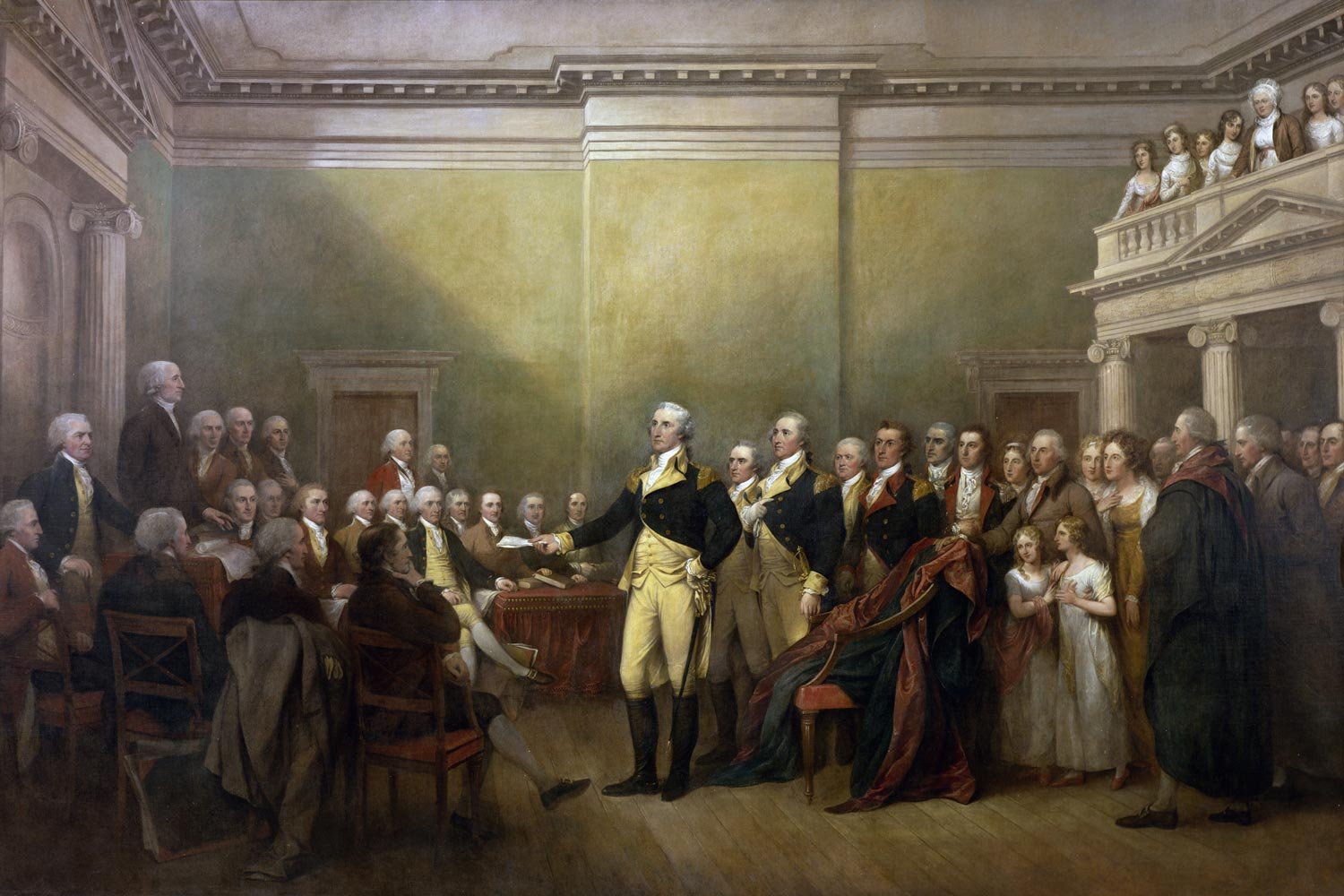George Washington, Commander of the Continental Army
After the clash at Lexington and Concord on April 19, 1775, all eyes turned north to Boston where a force of colonial militiamen was besieging the British. Congressional leaders knew we needed to mold this loose-knit assembly into an army and so Congress created the Continental Army on June 14, 1775.
When it came to finding the right man command it, George Washington was the logical choice. Sam and John Adams quickly nominated Washington and Congress unanimously approved. John Adams stated, “This appointment will have a great effect in cementing and securing the Union of these colonies.” Washington accepted the command but declined the salary offered to him, only asking that Congress cover his expenses.
To fully appreciate the task George Washington was given, it is important to understand the strength and capabilities of the two forces involved. First, keep in mind that at the start of the American Revolution the Continental army did not exist.
What we did have was a militia in every one of the thirteen colonies, all at various stages of development and all under their own leaders. The 20,000 relatively disorganized and under-equipped citizen-soldiers surrounding Boston were all militiamen. This was the force Congress “adopted” for its own in creating the Continental Army.
Most men who served in the Continental Army were between the ages of 15 and 30 and they came from all walks of life. These men signed up to serve for one to three years and starting pay was about six dollars ($180 today) per month. If they got out of line or failed to comply with their orders, punishment was severe and included lashings and even death.
When in camp they had one hot meal a day and received about a pound and a half of beef, a pound of bread, and two ounces of spirits (alcohol) each day, assuming Congress and the Quartermaster kept them supplied. All too often, the soldiers went without.
Although General Washington and other leaders made camp sanitation a priority, they were not very successful. In fact, for every soldier killed in combat, nine more died of disease, mostly due to poor sanitation.
When marching, the men carried about forty-five pounds of gear, everything from his weapon, ammunition, gun powder, mess kit (plate, knife, spoon, cup), knapsack, and maybe an extra blanket. On average, the soldiers marched about 15 miles a day.
Our Continental Army’s opponent was the British military, one of the most powerful in the world. The expeditionary force sent to America to quell the rebellion alone totaled 32,000 well-equipped and well-trained soldiers.
These units had more of everything than the Continentals; more uniforms, shoes, blankets, guns, bullets, gunpowder, cannons, horses, and so on. Moreover, it was commanded by seasoned, professional veterans who knew their business. Men who had engaged the French, Spanish, and Dutch on countless battlefields.
Adding to our challenges, the British Navy was the strongest in the world and controlled the seas. Their formidable armada could be used to both quickly transport troops from one location to another and to deny access to any vessels seeking to bring us supplies and other war materials. Additionally, while our army was terribly under-fed and under-clothed, British soldiers were kept well-supplied from England’s commissary.
Those were the odds stacked against General Washington as he rode north to take over the Continental Army surrounding Boston. While winning battles was critical to maintain morale at home and with the troops, Washington knew his primary mission as Commander was to build and then preserve the Continental Army.
He did this masterfully over the course of the next five years and the end he achieved, America’s independence, was nothing short of miraculous.
WHY IT MATTERS
So why does understanding the challenges General Washington and our Continental Army faced in the American Revolution matter to us today? To fully comprehend and appreciate what the Continental Army achieved, we must understand how the odds were stacked against them. These men took up arms and bravely faced the strongest nation in the world.
They suffered incredible hardships and were often malnourished. Many wore thread bare clothing and went without shoes in the dead of winter. They all risked their lives by joining our cause for freedom. Their perseverance deserves the admiration of all Americans.
SUGGESTED READING
The book Washington’s Crossing written by David Fischer won the 2005 Pulitzer Prize for History. It is a superb account of the trials and tribulations George Washington and our Continental army faced in 1776, and the glorious ending with Washington’s victories at Trenton and Princeton. It is a great read.
PLACES TO VISIT
Washington Crossing Historic Park is in southeast Pennsylvania and where George Washington crossed the Delaware on December 25, 1776 to save the cause of American freedom. The visitor’s center was renovated in 2012 and there are several historic buildings to see. It is well worth a visit.
Until next time, may your motto be “Ducit Amor Patriae,” Love of country leads me.











The only fighting in the Quasi-War occurred at sea, and mostly in the Caribbean. But with war at a fever pitch and French interests so close by in Louisiana, there was a very real concern in Congress about a possible French invasion of the United States from the west.